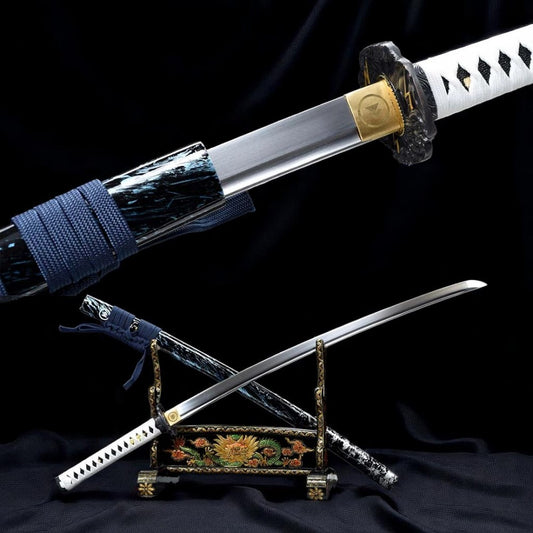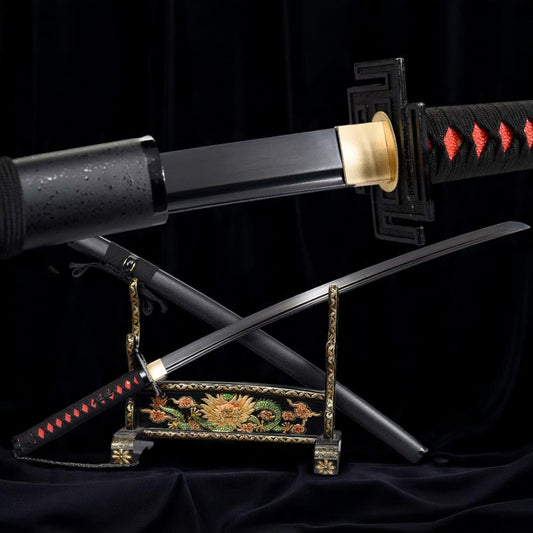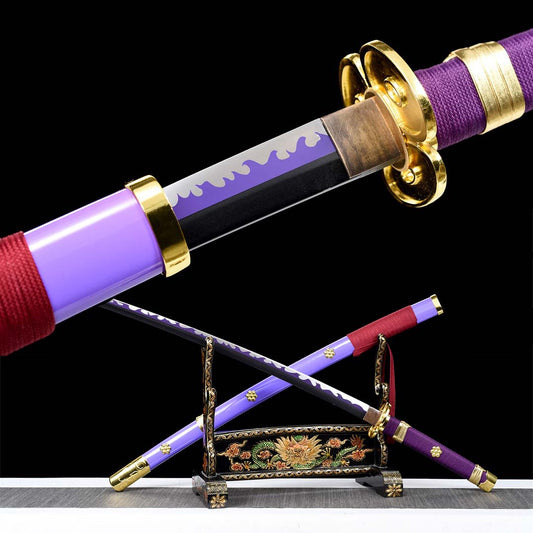
Katana Parts Explained – A Complete Customization Guide
Share
Introduction
When customizing your own katana, understanding each part of the sword is essential — not just for aesthetics, but also for balance, comfort, and performance. In this guide, we break down all the key components of the katana using their Japanese names, English translations, and plain-language explanations.
Each of these parts can be customized in our Katana Customizer to reflect your style, preferences, or martial arts practice.
1. Sharpening
Definition: The final edge polish of the blade. Options: Unsharpened (for display or cosplay), Sharpened (functional).
Buying Tip: If you're planning to use your katana for cutting (tameshigiri), always choose a sharpened edge. For purely decorative purposes, an unsharpened blade may be safer and sufficient.

2. Blade
Japanese: Ha (刃) Definition: The actual steel blade of the katana, curved and single-edged.
All our blades are full tang and hand-forged. You can choose different steels in our customizer:
- 1060 Carbon Steel: Ideal balance of hardness and flexibility.
- 9260 Spring Steel: Shock-resistant and perfect for practice.
- T10 Tool Steel: Very hard, holds edge longer. Excellent for serious users.
- Damascus Steel: Beautiful pattern, ideal for display + cutting.
3. BO-HI (Groove)
Japanese: Bo-hi (棒樋) Definition: A groove carved along the blade to reduce weight and create a signature sound when swung ("tachikaze").
With bo-hi: Lighter, better sound. Without bo-hi: Heavier, more cutting power.
4. Tsuka-ITO (Handle Wrapping)
Japanese: Tsuka-ito (柄糸) Definition: The wrapping over the handle (tsuka), typically cotton or leather.
Function: Provides grip and style. You can choose the color and material that fits your katana’s vibe.
5. SAMEGAWA (Rayskin)
Japanese: Samegawa (鮫皮) Definition: A layer of rayskin under the wrapping on the handle.
Function: Improves grip, adds traditional texture and depth. Available in natural, black, red, etc.
6. SAGEO (Cord)
Japanese: Sageo (下緒) Definition: The decorative and functional cord tied around the scabbard (saya).
Function: Used to secure the sword to the belt (obi). Also a strong visual accent.

7. Fittings – Tsuba, Fuchi, Menuki, Kashira
Tsuba (鍔)
Guard between blade and handle. Decorative and protective.
Fuchi (縁)
Collar between the handle and the tsuba.
Menuki (目貫)
Ornamental grip elements placed under the wrapping — both decorative and ergonomic.
Kashira (頭)
Pommel at the end of the handle. Helps balance the sword.
Tip: All fittings are customizable in coordinated or mixed themes. Choose a motif that represents your personality — from dragons to minimalist brass.
8. HABAKI
Japanese: Habaki (鎺) Definition: The blade collar that ensures a snug fit inside the scabbard (saya).
Function: Provides tension and supports structural balance between blade and handle.
9. SEPPA
Japanese: Seppa (切羽) Definition: Small spacers on either side of the tsuba.
Function: Keep all fittings tightly compressed and aligned.
10. SAYA (Scabbard)
Japanese: Saya (鞘) Definition: The wooden sheath that protects the blade.
Function: Not only a protective case, but also a major design element. Choose from classic black gloss, matte finishes, patterns, or even custom engravings.
Conclusion
Customizing your katana is more than choosing colors — it’s about building a sword that reflects your identity. Every component has a purpose, a name, and a story. From the tsuba to the hamon, knowing what each part does helps you create a blade that fits your hand, style, and intention.
🎌 Ready to begin? Head over to our Katana Customizer and build your own legendary sword.
Frequently Asked Questions
Q: What is the best steel for a beginner katana?
A: 1060 carbon steel is a solid choice. It's affordable, durable, and holds an edge well — great for first-time buyers.
Q: Should I choose a katana with bo-hi?
A: If you prefer lighter blades with a signature sound during practice, bo-hi is a great addition. For more cutting power, go without.
Q: What's the difference between tsuka-ito and sageo?
A: Tsuka-ito is the handle wrapping. Sageo is the cord tied around the scabbard. Both can be customized independently.




